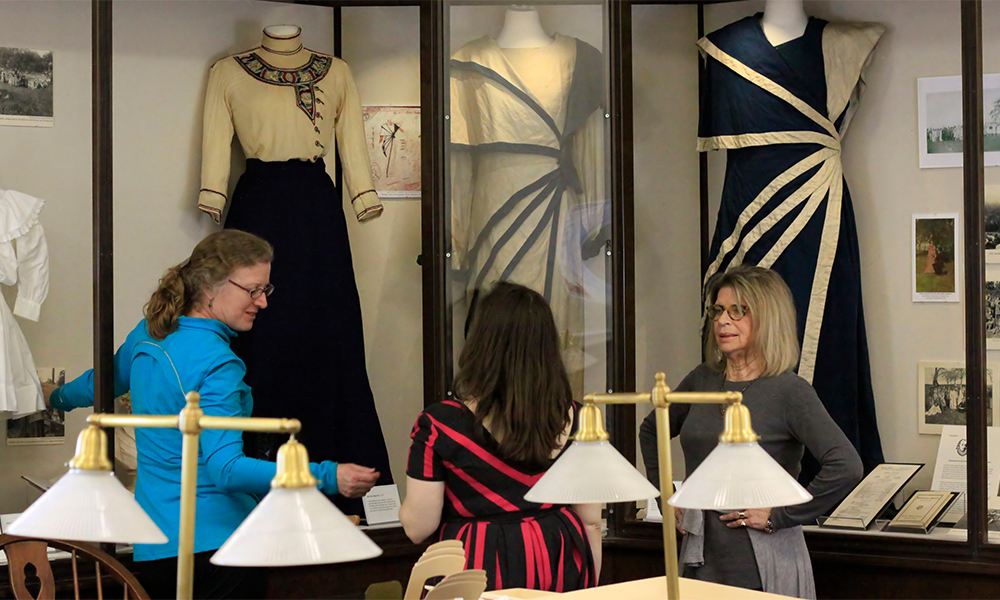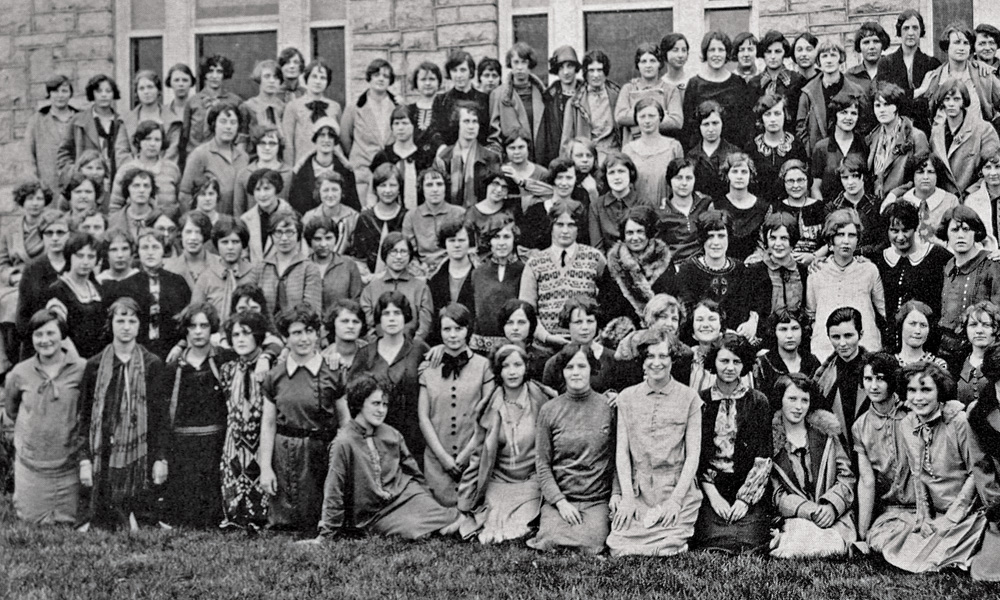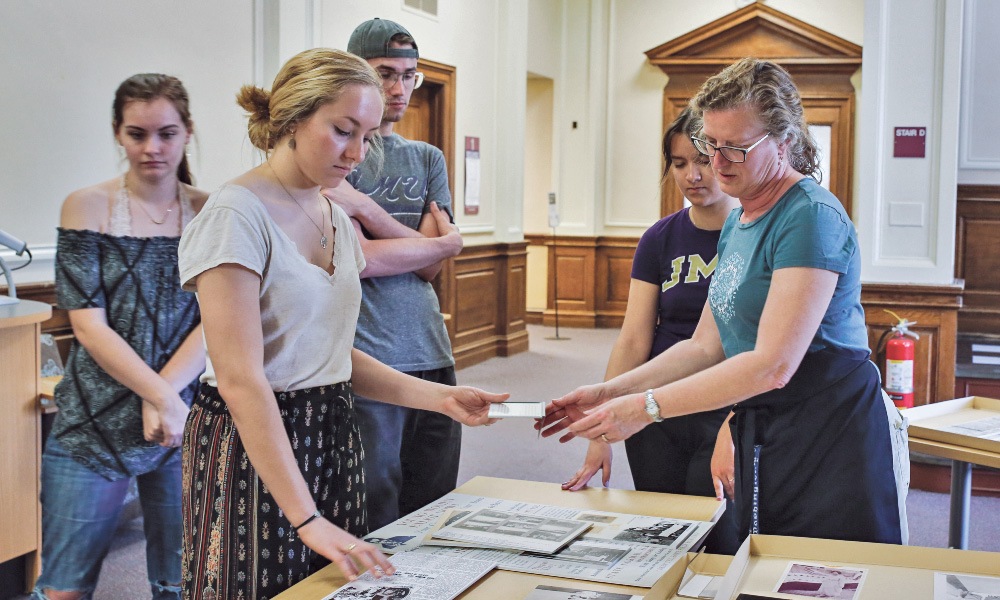Storytelling through clothing
The 19th Amendment: A History of Women's Rights at JMU
Featured Stories
SUMMARY: The exhibit, which celebrates the 100th anniversary of the 19th amendment being ratified, offers a window into the student experience at the height of the women’s suffrage movement, when James Madison University was the State Normal School for Women at Harrisonburg, only 12 years into its existence.
By Emily Blake
In 2008, Pamela Johnson, a professor in the School of Theatre and Dance, had already dedicated many years of work to building the school’s collection of thousands of items of historic clothing. The costume shop held hundreds of these items; the rest, ranging from the 1830s to the 1970s, were tucked away in carefully labeled boxes and totes in the Forbes Center. She wanted others to have the chance to enjoy them, but there wasn’t any secure, museum-quality exhibit space.
Out of the blue, Johnson received a call from Julia Merkel, a friend from graduate school working in JMU Libraries, to ask if she could provide clothing for the university’s Centennial Celebration. What followed was a 13-year collaboration and a series of six exhibits that told JMU stories through clothing from the historic collection in Theatre and Dance and items from Special Collections.
The most recent of these exhibits celebrates the 100th anniversary of the 19th Amendment being ratified, an event which gave many women in the U.S. the right to vote. The exhibit also offers a window into the student experience at the height of the women’s suffrage movement, when James Madison University was the State Normal School for Women at Harrisonburg, only 12 years into its existence.
What did you discover about the women on campus during the women’s suffrage movement through research for the 19th Amendment at JMU exhibit?
Merkel: One of the stories that I like to tell myself is that there were some subversive or rebellious faculty members in the early years who might have been responsible for choosing purple and gold as the school colors— coincidentally, those are the suffragette colors. Even though the official story is that they took the gold from the Lee Society and the purple from the Lanier Society, I really want to think that there were suffragettes who maybe had to keep a low profile back then but signaled their support with the colors.
Johnson: The women here were very present in the conversation. They were not cloistered in the way that many people think that women’s colleges were. And that, I think, is kind of confirming and exciting.
 |
| The 1926 freshman class photo shows a variety of hairstyles. Students were inspired by Dean Bernice Varner to bob their hair, despite school regulations against the style. |
What interesting stories have you uncovered while researching for these exhibits?
Merkel: Pam, talk about Bernice Varner flaunting President Duke’s rules!
Johnson: Varner, the dean of women, went to New York to a conference, and when she came back, she had bobbed hair, which President Duke, by whatever method, had forbidden. He had such respect for her that the students took permission to do it, too. I can’t remember the source of the anecdote, but it was said that the trash cans between the formerly named Jackson Hall and what would have been Harrison were filled with hair, because the students cut their hair in a bob.
What other stories would you like to share?
Johnson: Apparently, President Duke had forbidden students to ride with the aviators coming out of the local airports in their biplanes. He was on his little private golf course when a biplane “buzzed” him—it was his Dean of Students, Miss Varner! She was a real force of nature. President Duke respected her, and also she was a force that the students were happy to march behind.
|
"Material culture seems to be on the extinction list in this digital age. This kind of exhibit is an opportunity for people to experience material culture directly and to recognize the value of it." – Pamela Johnson, professor of theatre and dance |
I would love to hear more about the Joan of Arc statue at the entrance of Carrier Library.
Merkel: The one we have was a parting gift from President Julian Burruss and his wife, Rachel, to the students when they were leaving. We’re one of four women’s teachers colleges in the state, and I think all of them have a copy. So, we’ve never been able to find out exactly if it was coincidental, but having a symbol for the suffragette movement around the same time was providential for women pursuing their education when that was not the norm.
This was your sixth collaborative exhibit. What were the others about?
Merkel: We did one for the JMU Centennial in 2008 that had fashion from the founding of the school through the 20s, then we did the 30s and 40s through the Great Depression and World War II, then we did one for the 1950s. And then we did one for the library’s 75th and one for Shakespeare’s 400th anniversary and then, of course, our current one on women’s rights.
What is your process for creating these exhibits?
Merkel: There’s like a year of research that goes into each of these. The glass walls in my office are kind of like a big giant whiteboard when we’re planning these out. We’ll do trips to Pam’s storage area and new sketches of different pieces and try and map out the story, and we’ve got sticky notes just all over the place. You’re trying to design for a 3D space on a 2D surface. We would sip tea and brainstorm what pieces could tell the stories between Special Collections, the historic clothing collection and even our personal collections—an antique sewing machine and typewriter come to mind.
Johnson: Julia and I would agonize over which things we had to cut because we didn’t have enough space. Oh, how many times did we wish for more square footage!
Where did funding come from?
Merkel: Pam got a Burruss grant. There used to be little research grants in Special Collections for faculty to come and pinpoint an area of campus history that was important. Funding for the exhibits themselves was absorbed into department budgets.
 |
| Students and staff assemble an exhibit in Carrier Library. |
Why is this kind of exhibit so important?
Johnson: Material culture seems to be on the extinction list in this digital age. This kind of exhibit is an opportunity for people to experience material culture directly and, even more so, to recognize the value of it.
Merkel: You may not be aware, but the history of fashion is so tied to our material culture. Thinking back to the exhibit we did on World War II, the change in fabric from silk to rayon and the styles that moved through the 50s with these high fins and flares and hemlines changing—there’s so much connected and such a rich, rich treasure trove for telling a story. And some of the garments actually come from local families. So there’s this other level of connection to the community.
How has this exhibit provided an educational experience for the students you work with?
Johnson: As educators, Julia and I have always included—and frankly, rely very much on—the work of students. Inviting them to participate in the installation has been really, really satisfying.
Merkel: This is such a hands-on process. Involving students over the years in actually participating in the curation and the whole process has really given me things to talk about when writing recommendation letters for graduate school applications or for job placements. I’ve had several students over the years go on to careers in museum and library fields.
How can we keep creating deep learning experiences like this one?
Johnson: All of this richness came out of a collaboration. That’s something that I think needs to be explored. Julia and I have sat holding hands and weeping about the richness of this. Efforts need to be made to reach out and find these synapses between people in different divisions. That’s what higher education should be doing—nurturing and creating resources for those discoveries. It’s so exciting. I mean, it’s like going down a hole with a torch and finding something that you never believed was underground. That’s something that I will just treasure so much in my experience here.
EDITOR’S NOTE: The 19th Amendment: A History of Women’s Rights at JMU was the final collaboration between Johnson and Merkel. Johnson retired from the faculty of the School of Theatre and Dance this summer. Although the physical exhibit in the west wing of Carrier Library closed in April, visitors can still view the exhibit virtually thanks to the digital projects team in JMU Libraries. The website includes an interactive timeline of women’s rights at JMU, photos of early students, yearbook snapshots and more.
 |
